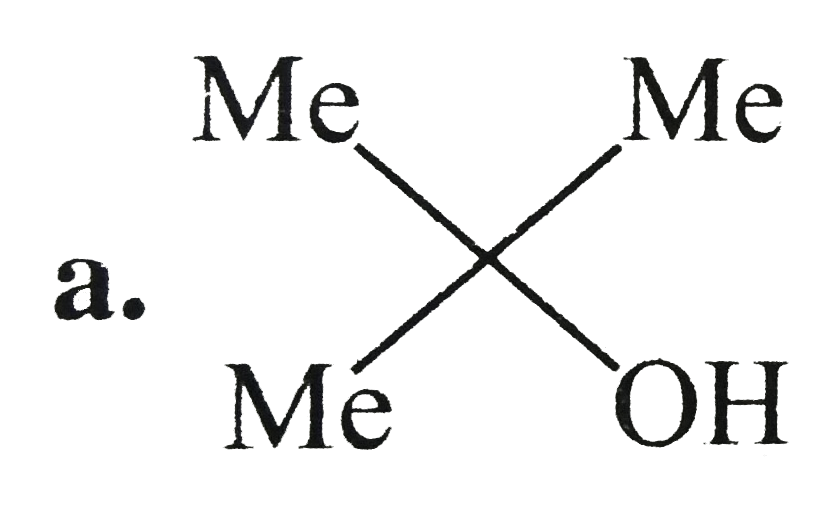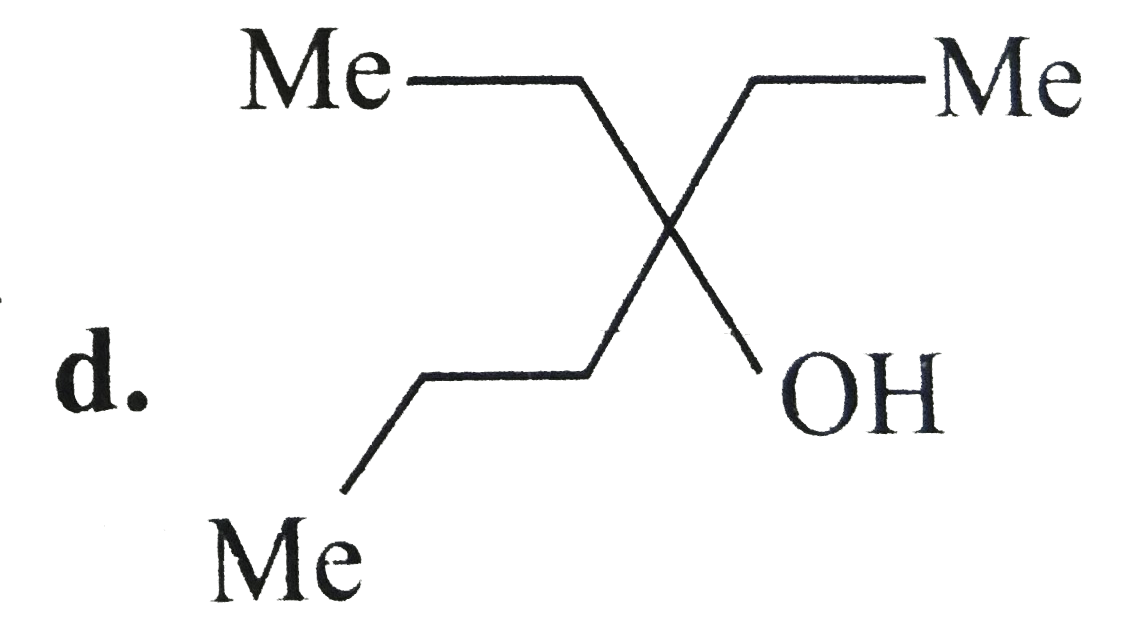Ethyl ester MeMgBr−−−−−→excessP. The product P will be :




The correct Answer is:A
To solve the problem of what product P is formed when ethyl ester reacts with excess methyl magnesium bromide (MeMgBr), we can follow these steps:
Step 1: Identify the Reactants
The reactant is ethyl ester, which can be represented as RCOOCH2CH3. Here, R is an alkyl group that is not specified.
Step 2: Understand Grignard Reagent Reaction
Methyl magnesium bromide (MeMgBr) is a Grignard reagent. Grignard reagents are nucleophiles and react with electrophiles. In this case, the carbonyl carbon of the ester is electrophilic.
Step 3: First Nucleophilic Attack
When MeMgBr reacts with the ethyl ester, the nucleophilic methyl group (Me−) attacks the carbonyl carbon of the ester. This leads to the formation of a tetrahedral intermediate:
RCOOCH2CH3+MeMgBr→R−C(OMgBr)(CH3)(CH2CH3)
Step 4: Elimination of Leaving Group
The tetrahedral intermediate collapses, resulting in the elimination of the leaving group (ethyl group, C2H5). This forms a ketone:
R−C(=O)(CH3)+C2H5OMgBr
Step 5: Second Nucleophilic Attack
Since we have excess MeMgBr, another molecule of MeMgBr will react with the newly formed ketone. The methyl group will again attack the carbonyl carbon:
R−C(=O)(CH3)+MeMgBr→R−C(OMgBr)(CH3)(CH3)
Step 6: Final Product Formation
After the second nucleophilic attack, we have another tetrahedral intermediate. Upon hydrolysis (using acidic workup), we will convert the magnesium alkoxide to an alcohol:
R−C(OH)(CH3)(CH3)
Step 7: Identify the Product
The final product P is a tertiary alcohol with the structure R−C(OH)(CH3)(CH3). If R is also a methyl group, the product is 2-methyl-2-propanol (tert-butyl alcohol).
Conclusion
Thus, the product P formed from the reaction of ethyl ester with excess methyl magnesium bromide is a tertiary alcohol.
The reactant is ethyl ester, which can be represented as RCOOCH2CH3. Here, R is an alkyl group that is not specified.
Methyl magnesium bromide (MeMgBr) is a Grignard reagent. Grignard reagents are nucleophiles and react with electrophiles. In this case, the carbonyl carbon of the ester is electrophilic.
When MeMgBr reacts with the ethyl ester, the nucleophilic methyl group (Me−) attacks the carbonyl carbon of the ester. This leads to the formation of a tetrahedral intermediate:
The tetrahedral intermediate collapses, resulting in the elimination of the leaving group (ethyl group, C2H5). This forms a ketone:
Since we have excess MeMgBr, another molecule of MeMgBr will react with the newly formed ketone. The methyl group will again attack the carbonyl carbon:
After the second nucleophilic attack, we have another tetrahedral intermediate. Upon hydrolysis (using acidic workup), we will convert the magnesium alkoxide to an alcohol:
The final product P is a tertiary alcohol with the structure R−C(OH)(CH3)(CH3). If R is also a methyl group, the product is 2-methyl-2-propanol (tert-butyl alcohol).
Thus, the product P formed from the reaction of ethyl ester with excess methyl magnesium bromide is a tertiary alcohol.
Topper's Solved these Questions
- GRIGNARD REAGENTS AND ORGANOMETALLIC REAGENTSBOOK - CENGAGE CHEMISTRY ENGLISHCHAPTER - GRIGNARD REAGENTS AND ORGANOMETALLIC REAGENTSEXERCISE - Exercises Archives (True/False)
1 Videos
- GRIGNARD REAGENTS AND ORGANOMETALLIC REAGENTSBOOK - CENGAGE CHEMISTRY ENGLISHCHAPTER - GRIGNARD REAGENTS AND ORGANOMETALLIC REAGENTSEXERCISE - Exercises Archives (Subjective)
9 Videos
- GRIGNARD REAGENTS AND ORGANOMETALLIC REAGENTSBOOK - CENGAGE CHEMISTRY ENGLISHCHAPTER - GRIGNARD REAGENTS AND ORGANOMETALLIC REAGENTSEXERCISE - Exercises (Single Correct)
47 Videos
- GENERAL PRINCIPLES AND PROCESS OF ISOLATION OF ELEMENTSBOOK - CENGAGE CHEMISTRY ENGLISHCHAPTER - GENERAL PRINCIPLES AND PROCESS OF ISOLATION OF ELEMENTSEXERCISE - Archives (Subjective)
14 Videos
- NCERT BASED EXERCISEBOOK - CENGAGE CHEMISTRY ENGLISHCHAPTER - NCERT BASED EXERCISEEXERCISE - Nuclear Chemistry (NCERT Exercise)
29 Videos
Similar Questions
Knowledge Check
Succinic acid Δ−−→(A)NH2−−→Δ(B)Br2−−→KOH(C),Product (C) will be :
ACH2−CO2H∣CH2−CH2−NH2BCH2−CO2H∣CH2−NH2CCH2−CO−2K+∣CH2−NH2DCH2−CO2H∣CH2−CH2−BrCH3−CH3∣CH−C≡CHexcess HBr−−−−−→
The product of the above reaction is :ACH3−CH3∣CH−Br∣CH−Br∣CH2BCH3−CH3∣CH−Br∣C=CH2CCH3−CH3∣CH−Br∣C∣Br−CH3DCH3−CH3∣CH−CH2−Br∣CH∣BrCH3−CH3∣C∣OH−CH3Na2Cr2O7−−−−−→cool (P) , product (P) in the reaction is :
ACH3−CH3∣C=CH2BCH3−CH3∣CH−CH3CCH3−CH3∣C∣CH3−O−CH3∣C∣CH3−CH3DNo reaction
1−Methylethylene oxideexcess−−→HBrX, Product 'X' will be-
View Solution1−Methylethylene oxideexcess−−→HBrX, Product 'X' will be-
View Solution DIBAL-H−−−−−→ΔProduct, Product is :
DIBAL-H−−−−−→ΔProduct, Product is :
View Solution HI−−−−→low temp product are
HI−−−−→low temp product are
View SolutionH−C≡C−HHgSO4−−−−−−→H2SO4dil.NaOH−−−−−→Δ−−→P. The final product P is
View Solution
